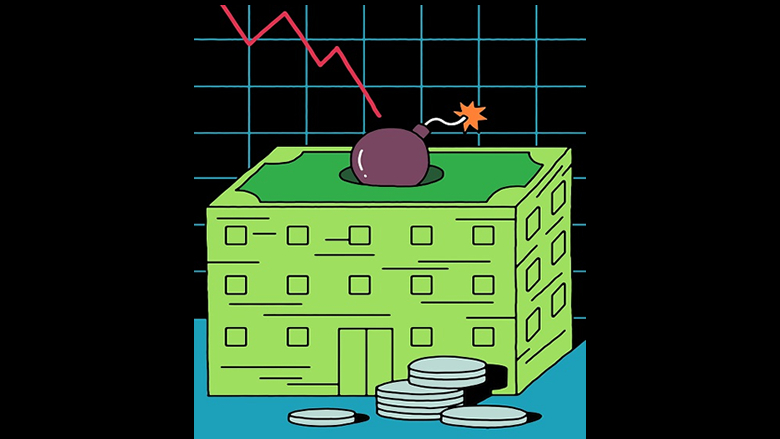n January of 2019, Mark Carney, the governor of the Bank of England, appeared before a House of Commons committee to discuss global threats to financial stability. At that time, the U.S. unemployment rate was below four per cent, the gross domestic product was growing steadily, and Donald Trump was busy boasting about “the greatest economy ever.” But, despite these favorable statistics, staffers at the bank had identified a potentially serious problem on the horizon: a rapid buildup of corporate debt, which was associated with a potentially alarming decline in lending standards. Carney compared what was happening in the corporate-debt markets to the subprime-mortgage boom that culminated in the great financial crisis of 2008 and 2009. Citing the rise of “covenant lite” loans that placed very few restrictions on corporate borrowers, Carney said, “The subprime analogy isn’t perfect, but it’s on the road to ‘no doc’ underwriting, which happened eleven years ago.”
Carney’s warning didn’t make a big splash in this country. On Wall Street, it was widely acknowledged that there had been some excesses in the corporate-debt market, and that credit standards had slipped. Decades ago, blue-chip corporations jealously guarded their top-notch credit ratings: they were wary of issuing too much debt. But, in a new era of finance-driven capitalism, companies like American Airlines, Hertz, and Staples borrowed heavily to finance acquisitions, stock buybacks, and, in some cases, leverage buyouts sponsored by private-equity companies. Between the fourth quarter of 2009 and the fourth quarter of 2019, the total debt of non-financial corporations rose from $6.1 trillion to $10.1 trillion, according to figures from the Federal Reserve Board.
Much of this new lending came in the form of issuing bonds, but newer forms of credit also proliferated. Between 2007 and 2019, the value of outstanding “leveraged loans,” which are syndicated loans extended to companies that credit agencies rate below investment-grade, rose from $554 billion to $1.2 trillion, according to S & P Global. In turn, many of these leveraged loans were used to create collateralized loan obligations, or C.L.O.s. These complex and opaque products are close cousins of C.D.O.s—collateralized debt obligations—which played a big role in the subprime boom and bust. In creating both C.D.O.s and C.L.O.s, financial alchemists on Wall Street took a pool of sub-investment-grade loans and sliced and diced them into various “tranches,” some of which were then given triple-A ratings and marketed to investors as a source of safe and regular yields. By the end of 2019, there was about seven hundred billion dollars’ worth of C.L.O.s in existence, according to industry estimates.
Many of these C.L.O.s are directly associated with private-equity partnerships, which benefitted in at least two ways from their growth. Corporations sponsored by private-equity companies often used leverage loans to finance buyouts of their stockholders at very high multiples of earnings and cash flow. Some leading private-equity companies also got involved in the business of organizing and managing the C.L.O.s, where many leveraged loans ended up. According to CreditFlux, a news service that covers C.L.O.s and credit funds, the Carlyle Group and GSO Capital Partners, a subsidiary of the Blackstone Group, are two of the three biggest C.L.O. managers. Apollo, Kohlberg Kravis Roberts, and CVC Partners are also prominent players. Given their ownership of many highly leveraged companies and their central role in the C.L.O. industry, private-equity firms obviously have a huge financial stake in preventing a debt blowup.
The New Yorker’s coronavirus news coverage and analysis are free for all readers.
As long as the economy was doing well, the debate about the potential dangers of excessive corporate debt remained theoretical. With interest rates at low levels, most corporate lenders, even highly leveraged ones, didn’t have much trouble meeting their interest payments or rolling over their debts. Default rates remained low, and some policymakers assured themselves that, even if they rose, the financial system was strong enough to sustain any potential losses. “Business debt has clearly reached a level that should give businesses and investors reason to pause and reflect,” Jerome Powell, the chairman of the Federal Reserve, said, in a speech last May. “However, the parallels to the mortgage boom that led to the Global Financial Crisis are not fully convincing. Most importantly, the financial system today appears strong enough to handle potential business-sector losses, which was manifestly not the case a decade ago with subprime mortgages.”
In the second half of last year and the first two months of this year, the corporate-credit boom continued. In February alone, thirty billion dollars in C.L.O.s were issued. But, as the coronavirus spread and widespread shutdowns began, everything changed abruptly. As many corporations faced the prospect of a big fall in their revenues, lenders and investors in debt products reassessed the probability that these firms would be able to meet their financial obligations. Credit spreads, which are a market measure of risk, widened dramatically, and the most speculative parts of the corporate-debt markets practically seized up. Issuance of leveraged loans and C.L.O.s fell precipitously. Where previously highly indebted companies had been able to raise practically any amount of money against practically any collateral, they suddenly had great difficulty raising any.
“The leveraged-loan market was screaming-hot in January and February, and then, suddenly, in the course of a couple of weeks, everything froze up,” Will Caiger-Smith, who oversees coverage of leveraged finance at Debtwire, a financial-news and data service, told me. In February, about thirty billion dollars’ worth of C.L.O.s were issued. In March, the figure fell to three billion. (In April, it was four billion.) “Basically,” Caiger-Smith said, “the pandemic has put the breaks on new issuance.”
It has also pushed many highly indebted firms toward insolvency. Already, some well-known retailers, including J. Crew and Neiman Marcus, have filed for Chapter 11 bankruptcy protection from their creditors. (Both companies had loaded their balance sheets with debt in private-equity deals.) These highly publicized filings are just the most visible sign of the widespread distress in the more speculative regions of the credit markets. In April, there were eleven leveraged-loan defaults, which is “the most ever during a month, exceeding the previous record of 10 in October 2009,” a recent report from S & P Global noted. With “grim forward indicators thanks to the Covid-19 pandemic, market sources expect more defaults ahead,” the report went on. The credit-ratings agency has predicted that leveraged-loan defaults could hit ten per cent by the end of this year.
So far, at least, there hasn’t been a blowup in the C.L.O. market to match what happened to the C.D.O. market in 2007 and 2008. But, as the number of defaults rises and the ratings agencies issue downgrades for large numbers of the leveraged loans that got sliced and diced to go into the C.L.O.s, the pressures on these opaque vehicles are growing. In a recent interview with the Financial Times, Matthew Mish, a credit analyst at UBS, said, “CLOs and the loans underpinning them are ground zero in terms of the vulnerability of this crisis.”
If your recent financial reading has been confined to reports about the stock market, you won’t have heard much about corporate debt. Ever since March 23rd, when the Fed announced that it would use its “full range of authorities” to maintain “the flow of credit to American households and businesses,” many investors have been assuming that the threat of a serious debt crisis is behind us. And, as far as some parts of the credit markets go, that might be correct.
In late March and early April, the Fed said it would use its digital printing press to start purchasing corporate bonds, and also team up with the Treasury Department to lend directly to corporations that were having trouble raising money. This was the first time since the great financial crisis of 2008 that the central bank had invoked its emergency powers to lend to non-banking companies. After the Fed’s announcements, the investment-grade bond market and the upper reaches of the junk-bond market both staged impressive recoveries. As credit spreads narrowed, even some highly leveraged companies that were hit hard by the shutdowns, including Boeing, Carnival Cruise Lines, and Delta Air Lines, were able to place large bond issues. The money these companies raised—twenty-five billion dollars, in Boeing’s case—greatly improved their chances of surviving the pandemic.
As investors’ confidence returned, the prices of leveraged loans also partially rebounded. But this doesn’t mean that all highly indebted companies are safe. The Fed extended a lifeline to investment-grade corporations and to companies, such as Ford, that were investment-grade before the pandemic reached the United States and have since seen their debt downgraded. But it held off from offering direct assistance to the most risky and highly leveraged companies, many of which rely on leveraged loans and the C.L.O. market that undergirds it. Those firms were left to fend for themselves and raise funds from private sources as best they could. “By supporting the credit market broadly, the Fed has benefitted the leveraged-loan market indirectly,” Caiger-Smith, of Debtwire, noted. “It hasn’t, however, solved the C.L.O. problem.”
Credit-ratings agencies like Moody’s and S & P, meanwhile, are continuing to downgrade many of the loans that underpin C.L.O.s. This potentially creates a dangerous situation. Many C.L.O.s are supposed to maintain a certain percentage of higher-rated loans. If they can’t do this, insurance companies and other holders of certain C.L.O. tranches may be forced to sell, which could create more instability. Eventually, some C.L.O.s could start to unravel, much like subprime C.D.O.s unravelled in 2008. “If we are right, we are only in the fourth inning of downgrades,” UBS’s Matt Mish told me, “and there is going to be more downward pressure.”
Mish added that leveraged loans and C.L.O.s aren’t the only types of credit product that are in trouble. He pointed to so-called middle-market loans, which are credits that investment funds and specialty finance companies extend to medium-sized corporations, often in connection with a leveraged buyout. Over the past decade, these buyouts have become so popular that there is now about a trillion dollars’ worth of middle-market loans outstanding. “This market is highly correlated with the leveraged-loan market,” Mish said. “There are the same concerns about lending standards. A lot of the collateral underpinning these loans is very low-quality and very highly leveraged.” Another attribute that middle-market loans share with leveraged loans is that the Fed and the Treasury Department haven’t targeted them for support, quite possibly because of their association with the private-equity industry. “Most people on Capitol Hill don’t want to support private equity,” Mish said. “These firms have been some of the most aggressive of all, essentially putting themselves in a very vulnerable position.”
I asked Mish why stock-market investors were ignoring the risks. To the extent that investors were focussing on high-quality, low-leverage companies, such as tech giants, he said, their optimism was reasonable. The danger, he added, was that investors may be getting too complacent about the rising number of credit downgrades and credit defaults, which could take a considerable period to play out. “Over the next few months, people will start to realize that the credit downgrades are continuing, and eventually some of the economic stimulus will wear off,” he said. “You’ll also see a big hit to corporate earnings, which will further increase leverage ratios. That’s when we think there will be another wave of defaults, as people see the current capital structure is not sustainable.” Ultimately, Mish said, “the result could be a credit crunch in the loan market that threatens some of the core plumbing of the lending system.”
In the aftermath of the great financial crisis of 2008, Ben Bernanke, the then chairman of the Fed, famously attributed the crash to problems with “the financial plumbing.” Comparisons need to be made carefully, however. In 2007 and 2008, what turned C.D.O.s and other types of subprime securities into financial weapons of mass destruction was the fact that many of the banks that created them turned out to have large exposures to their own toxic handiwork. When investors recognized these exposures, they started to withdraw their money from many different markets, and the financial system virtually seized up.
Many people on Wall Street insist there is little chance of a repeat. Capital reserves in the financial industry are larger than they were in 2009, and banks tend to sell the leveraged loans they issue in the secondary market rather than keeping them on their own books. The same is true of C.L.O.s. According to figures from S & P Global, banks own less than fifteen per cent of all C.L.O.s; the biggest investors in these securitizations are insurance companies and asset managers. Moreover, the Fed’s rapid actions have reassured many investors that it will do whatever is necessary to prevent a big blowup.
Mish said he didn’t think there would be a 2008-style systemic crisis, in which loan losses threaten to bring down the banking system. He agreed with Powell that the big banks probably have enough capital to withstand any pain they suffer. But he also said that some individual financial institutions could face substantial losses.That, in itself, might carry some serious consequences. If investors suspect that some big banks are more heavily exposed to problematic loans than previously thought, it could, in a worst-case scenario, create a self-fulfilling panic. As in 2008, it isn’t entirely clear how much over-all exposure big banks have to the riskiest forms of debt, such as leveraged loans and C.L.O.s.
In December, 2019, the Financial Stability Board, an international group of central bankers and bank regulators, said that exposures “are concentrated among a limited number of large global banks and have a significant cross-border dimension.” At the end of 2019, according to S & P Global, the three biggest bank holders of C.L.O.s were Wells Fargo, JPMorgan Chase, and Citigroup, which together held about one hundred billion dollars’ worth of them. And just looking at figures like these doesn’t give a full picture of the risks some banks face. “Their exposures could increase further in stress as a result of revolving credit facilities being drawn down by leveraged borrowers and banks being unable to syndicate loans they intended to distribute, which could adversely affect bank capital and liquidity,” the report from the Financial Stability Board said. “Banks are also exposed through the financing of non-bank investors in leveraged loans and C.L.O.s.”
After the coronavirus shutdowns began, many highly indebted companies did draw down their revolving lines of credit, just as predicted. Still, the big U.S. banks insist that they are financially strong—so strong, in fact, that they are continuing to issue dividends to their stockholders. If the economy rebounds rapidly, and corporate revenues rebound with it, the dangers of a debt blowup could recede. But if the slump is extended the pace of corporate defaults will accelerate, and the markets could well start to pay more attention. The corporate-debt problem isn’t going away. On Friday, Hertz became the latest heavily indebted corporation to file for bankruptcy protection from its creditors. Fitch, a credit-ratings agency, is predicting that the default rate for leverage loans will be higher in 2021 than 2020.
If credit spreads do widen again, and the stock market takes another dive, the Fed and the Treasury Department might feel compelled to extend financial support to even the most irresponsible and highly indebted corporate risk-takers, including those sponsored by private-equity companies. As Powell pointed out on “60 Minutes” last week, “there is really no limit” to what the central bank can do with the emergency lending programs it has introduced.
So far, the private-equity industry’s efforts to engineer a bailout of the riskiest types of credit have largely failed. The Fed did authorize one of its emergency facilities to purchase Exchange Traded Funds that own bonds issued by companies that were investment-grade before the coronavirus hit. Another Fed program, the Term Asset-Backed Securities Loan Facility (talf), will soon start providing collateralized loans to purchasers of the triple-A-rated tranches of a particular kind of C.L.O., known as a static C.L.O. Both of these measures were fairly narrowly targeted, however. The talf is only targeted at new C.L.O.s. Neither the Fed nor the Treasury has announced a rescue package for the great majority of existing C.L.O.s and leveraged loans.
This isn’t for want of aggressive lobbying on the part of private-equity companies, which have close ties to the Trump Administration. Stephen Schwarzman, the co-founder and chairman of Blackstone, the biggest private-equity firm in the world, is a supporter and confidant of the President. “There is nothing they haven’t tried, but so far they have been largely unsuccessful,” Dennis Kelleher, the president of Better Markets, a nonprofit organization that was founded after the last financial crisis to promote the public interest, told me. But the situation is still evolving, Keller pointed out; the private-equity lobbyists are relentless, and the debt problem is an intractable one. “The Fed was insufficiently concerned about the corporate-debt bubble that was building up over the past decade,” Keller said. “So here we are, in an over-leveraged system that gets hit by a pandemic. It’s hard to see how the Fed or the country can extract themselves from that in any reasonable time frame.”





